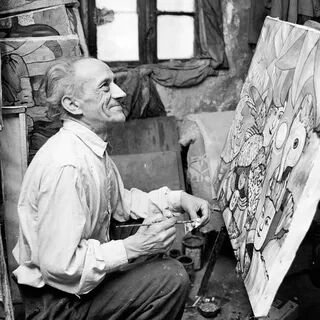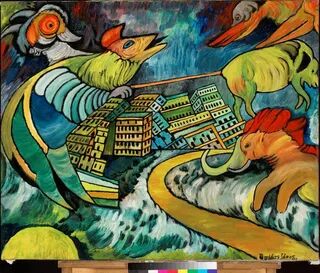
1905 - 1977 Painter, poet
Biography
János Balázs was a pioneering figure in Hungarian Romani poetry and painting. He started drawing as a child but stopped for decades, only resuming at age 63 in 1968. His magical works blend his inner visions with the mystical world of Romani tales and elements of reality. His art is characterized by monumentality, surreal connections between motifs that fill the entire canvas, and an intensified color palette.
Both his grandfather and father were well-known violinists. At five, he lost his mother and moved with his family to a Romani settlement in Pécskődomb, Salgótarján.
Balázs only began his education but never reached the third grade. Despite this, he learned to read and became a voracious reader. Words became everything to him, and he accumulated vast amounts of knowledge and experiences, which he later expressed in a unique way through his poems and visual art. Known for his grumpy, restless nature, Balázs lived as a jack-of-all-trades, repairing instruments, cleaning chimneys, gathering mushrooms, and mastering various skills. He became a thinker and a debater in his youth.
He served in the 23rd infantry regiment in Losonc and was sent to the front at age 37. In 1944, he was taken as a prisoner of war, and although the war soon ended, he spent three more years in captivity in the Saratov POW camp in the Soviet Union. During this time, he continued to read extensively, immersing himself in Hungarian classics as well as the works of Shakespeare, Homer, and Balzac. He returned home to Salgótarján at the age of 43 and never left the town again.
Living as a recluse, Balázs began writing poetry and painting. The forest was his refuge; he gathered fallen branches, ate wild fruits, and scavenged coal from the slag heaps. Local children, seeing his drawings, persuaded him to start painting again, bringing him materials like rags, wood scraps, and leftover paints.
The history, fate, and myths of both the Hungarian and Romani people, combined with his vast encyclopedic knowledge, appeared in his poems and took form in his visual works.
Balázs was fascinated by everything: history, the fate of humanity, the Romani settlement, flowers, and animals. He matured into a Renaissance man as a hermit, wanting to contribute to every topic and every aspect of life. His knowledge merged with his deep-rooted ancestral thoughts, which perhaps explains the riotous color palette of his works. His paintings are chaotic mysteries, as he himself said, hiding the existence of the entire world. Though he could never part with his works, he once decided to sell 13 paintings to finance the publication of his poetry collection Füstölgések (Smouldering).
Although the media discovered him, he struggled with fame. The Corvina Publishing House released a book titled Ecsettel és irónnal (With Brush and Pen), which is a selection of his poems and paintings.
János Balázs remains a unique phenomenon in both Hungarian and international art. He developed a singular, unrepeatable artistic language. His active creative period spanned just eight years. His poetry and painting were not random occurrences—they were destined to be created and are equally important for Hungarian and Romani culture. He painted like a child trapped in an adult’s body, enabling him to see and depict the world through a fantastical lens filled with colors, animals, landscapes, and people.
2022
- Documenta 15 - Kassel Biennial
Documenta Kassel, Germany - Exhibition of János Balázs, Roma poet and painter solo exhibition
Liszt Institute Brussels, Brussels, Belgium
2020
- Works by artists from Salgótarján in the collection of the Béla Dornyay Museum group exhibition
Béla Dornyay Museum Salgótarján, Hungary
2019
- Paintings by János Balázs from the Horn Collection (solo exhibition)
Kunsthalle Budapest, Hungary
2017
- Balázs János solo exhibition
Kálmán Makláry Fine Arts Budapest Hungary
2005
- János Balázs - solo exhibition
Kieselbach Gallery and Auction House, Budapest, Hungary
PUBLIC COLLECTIONS
Hungary
- Béla Dornyay Museum – Salgótarján, Hungary
- Hungarian National Gallery
- Museum of Hungarian Naive Art – Kecskemét, Hungary
- Romano Kher – Budapest, Hungary

